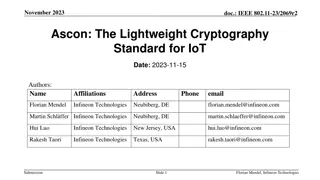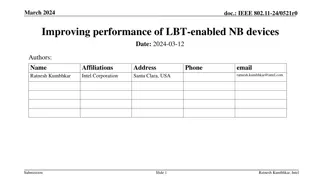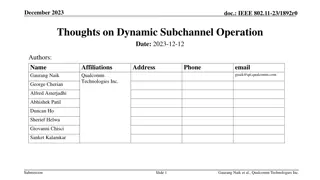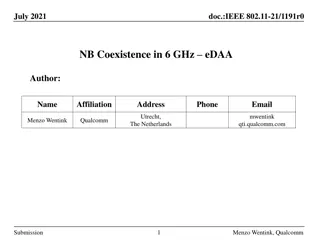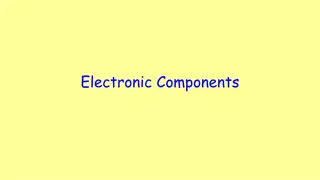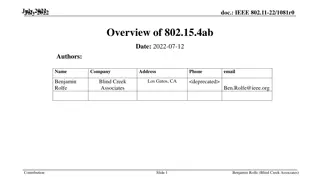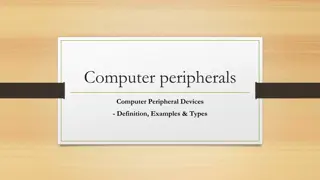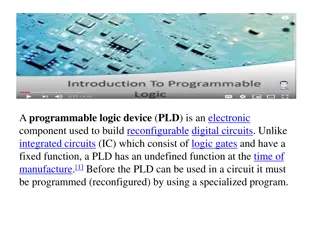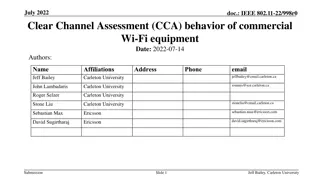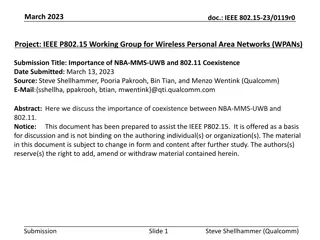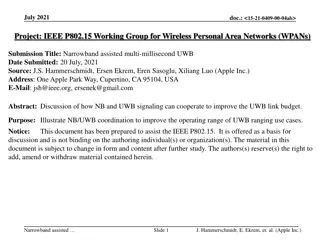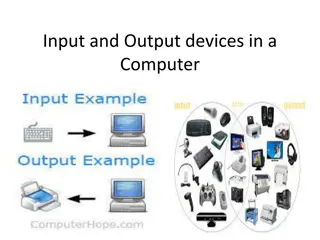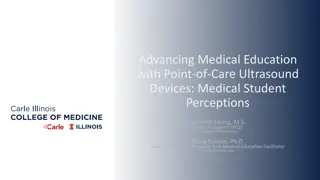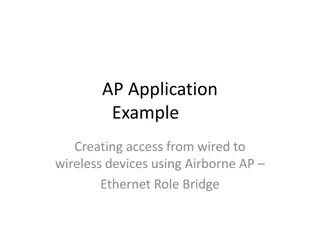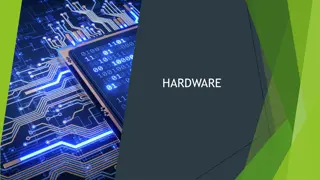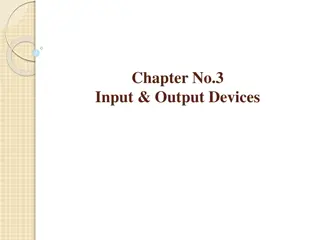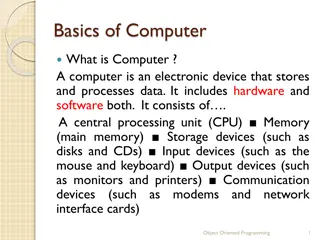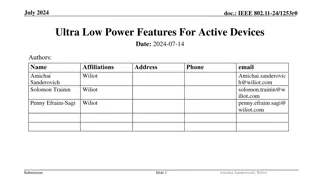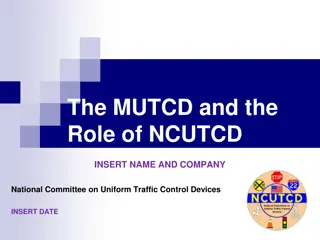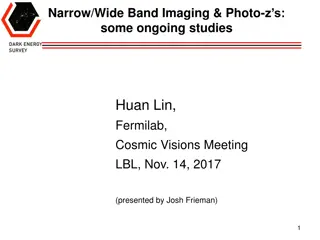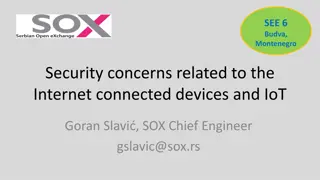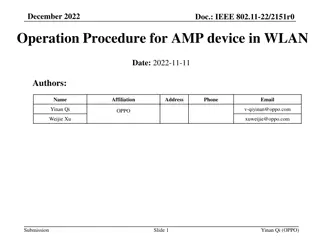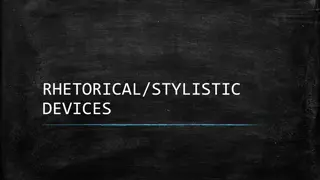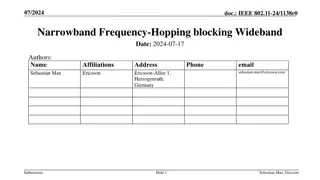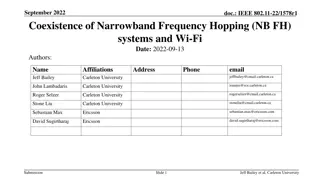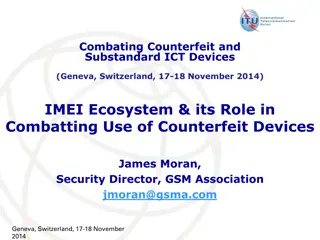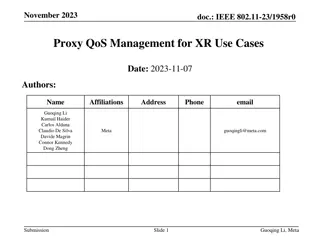Computer Peripherals and Interfacing
Computer peripherals are external devices that enhance the functionality of a computer. They include input devices like keyboards and mice, output devices like printers and monitors, and storage devices like hard disk drives and solid-state drives. Interfacing circuits connect these peripherals to t
1 views • 6 slides
Ascon: The Lightweight Cryptography Standard for IoT
The November 2023 document IEEE 802.11-23/2069r2 discusses the importance of secure data storage and communication in IoT devices due to the increasing number of connected devices and potential security threats. It introduces Ascon as a lightweight cryptography standard selected by NIST for protecti
0 views • 26 slides
Lightweight Cryptography Standard for IoT - November 2023 IEEE Presentation
IEEE 802.11-23/2069r1 presents Ascon as a lightweight cryptography standard for IoT devices. With the increasing number of connected devices, protecting data on IoT devices becomes crucial. NIST selects Ascon to safeguard small devices, offering authenticated encryption and hashing efficiently. Asco
3 views • 26 slides
Understanding Network Devices and Connectivity
Network devices play a crucial role in connecting computers and printers to networks, facilitating fast and secure data transfer. These devices, such as network interface cards and WiFi cards, help devices communicate effectively on the same or different networks. MAC addresses uniquely identify dev
6 views • 31 slides
Improving performance of LBT-enabled NB devices
This submission delves into optimizing the performance of narrowband signals like Bluetooth by utilizing Listen-Before-Talk (LBT) for channel access in the 5 and 6 GHz frequency bands. The study explores the potential advantages for Bluetooth devices in improving efficiency and reliability through L
0 views • 15 slides
Dynamic Subchannel Operation in IEEE 802.11-23/1892r0: Enhancing Spectral Efficiency
The document discusses the implementation of Dynamic Subchannel Operation in IEEE 802.11 to address underutilization of bandwidth by narrowband devices. By allowing dynamic switching to secondary subchannels, the aim is to maximize spectral efficiency and enable communication with narrowband STAs on
0 views • 9 slides
Understanding Input and Output Devices in Computing
In computing, input and output devices play a crucial role in enabling communication between users and computers. Input devices are used to enter data into a computer, while output devices display or provide the results of processed information. Common input devices include keyboards, mice, and joys
0 views • 17 slides
Coexistence Challenges and Solutions in 6 GHz Networks
Various submissions address narrowband (NB) coexistence issues in the 6 GHz frequency band, focusing on Enhanced Detect and Avoid (eDAA) mechanisms to ensure harmonious coexistence between Wi-Fi and NB devices. The proposals discuss channel access rules, interference measurements, simulation results
1 views • 14 slides
Understanding Basic Input/Output Operations in Computer Organization
Basic Input/Output Operations are essential functions in computer systems that involve transferring data between processors and external devices like keyboards and displays. This task requires synchronization mechanisms due to differences in processing speeds. The process involves reading characters
0 views • 11 slides
Understanding Electronic Components and Input/Output Devices
Explore the world of electronic components, input devices, and output devices through energy changes and symbol representations. Learn about LEDs, resistors, and energy conversions in a hands-on manner. Discover the role of various devices like microphones, solar cells, loudspeakers, and diodes in c
1 views • 24 slides
Overview of IEEE 802.15.4ab - Next Generation UWB
An overview of the IEEE 802.15.4ab focusing on next-generation Ultra-Wideband (UWB) technology, specifically the narrowband/UWB hybrid proposals and coexistence with other services. The document explores the enhancements to UWB physical layers, medium access control, and ranging techniques while mai
2 views • 15 slides
Understanding Computer Peripheral Devices: Definition, Examples, and Types
Learn about computer peripheral devices, which enhance a computer system's functionality. Examples include mice, keyboards, monitors, printers, and scanners. These devices can be categorized into input, output, and storage devices, each serving a specific purpose to expand the capabilities of your c
2 views • 13 slides
Understanding Programmable Logic Devices (PLD) in Digital Electronics
Programmable Logic Devices (PLDs) are versatile electronic components used to create reconfigurable digital circuits, distinct from fixed-function integrated circuits. PLDs require programming before use, enabling customization for specific functions. This article explores PLDs, digital electronic s
0 views • 10 slides
Automotive Grade 10 Joining Methods: Locking Devices Overview
Automotive Grade 10 explores joining methods using locking devices to prevent nuts from loosening due to movement and vibration. Friction-locking devices include lock nuts, stiff nuts, and special washers. Positive-locking devices tighten nuts securely with slotted nuts, crowned nuts, tab washers, a
1 views • 7 slides
Clear Channel Assessment (CCA) Behavior of Commercial Wi-Fi Equipment
This document, dated July 2022, delves into the Clear Channel Assessment (CCA) behavior of commercial Wi-Fi equipment in response to Narrowband Frequency Hopping (NB FH) signals. It explores the regulatory framework around license-exempt frequency bands in the USA and Europe, highlighting the specif
0 views • 22 slides
Importance of NBA-MMS-UWB and 802.11 Coexistence in Wireless Personal Area Networks
Discussing the significance of coexistence between Narrowband Analog Multi-Media Services Ultra-Wideband (NBA-MMS-UWB) and IEEE 802.11 technologies in shared frequency bands, emphasizing interference mitigation, enhanced ranging capabilities, and other coexistence improvements to support various dat
0 views • 14 slides
Enhancing UWB Performance Through NB/UWB Coordination
Detailing how narrowband (NB) and ultra-wideband (UWB) signaling can work together to improve UWB link budget, extending the operating range for UWB ranging use cases. The document discusses interference mitigation techniques, proposed solutions for improved link budget and reduced air-time, and enh
0 views • 10 slides
Understanding Input and Output Devices in a Computer
Input devices play a crucial role in sending data to a computer, allowing users to communicate instructions for processing, display, storage, and transmission. Key input devices include keyboards and mice, each serving specific functions and enhancing data collection and accuracy. Discover the advan
0 views • 17 slides
Perceptions of Medical Students on Point-of-Care Ultrasound Devices
This study evaluates medical students' perceptions of SonoSite Edge II and Butterfly iQ ultrasound devices for enhancing learning experiences in ultrasound and medicine. The research involved first-year medical students using both devices and providing feedback through pre- and post-session surveys.
3 views • 10 slides
Guide to Creating Access from Wired to Wireless Devices Using Airborne AP Ethernet Bridge
Explore a comprehensive guide on setting up access from wired to wireless devices using Airborne AP Ethernet Role Bridge. Learn how to connect a PLC and a wireless laptop to the same network, configure settings for both devices, and successfully ping between the devices. Follow step-by-step instruct
2 views • 7 slides
Understanding Computer Hardware: Key Input Devices and Pointing Devices
Explore essential computer hardware components such as keyboards, mice, and pointing devices. Learn about the different types of keyboards including ergonomic and laser keyboards, as well as various mouse types like wireless, cabled, and optical mice. Discover how pointing devices like touch screens
0 views • 18 slides
Overview of Computer Input and Output Devices
Input devices of a computer system consist of external components like keyboard, mouse, light pen, joystick, scanner, microphone, and more, that provide information and instructions to the computer. On the other hand, output devices transfer information from the computer's CPU to the user through de
0 views • 11 slides
Understanding Input and Output Devices in Computers
Input devices like keyboards, mice, joysticks, light pens, scanners, and more play a crucial role in interacting with computers. This chapter explores the functions and features of various input devices used in computing, such as keyboards for data input, mice for cursor control, and joysticks for C
0 views • 12 slides
Understanding Basics of Computer Systems
A computer is an electronic device that stores and processes data using hardware and software components. It consists of a CPU, memory, storage devices, input/output devices, and communication devices. The CPU includes a Control Unit and Arithmetic Logic Unit, and the memory stores data in bytes. St
0 views • 57 slides
Intro to Poetic Devices in "The Raven
Explore the use of poetic devices in Edgar Allan Poe's "The Raven" with a focus on end rhyme, internal rhyme, rhyme scheme, personification, and more. Learn to identify and analyze these devices as they influence the understanding and impact of the poem's stanzas. Engage in a practical exercise to a
0 views • 43 slides
Understanding NXDN Technology in West Central Florida
NXDN is an ultra narrowband digital mode with 6.25 KHz FDMA modulation, offering clear audio and data streaming with support for multiple talkgroups. It provides superior weak signal performance, decoding down to -116 dBm, ideal for indoor use. First-generation NXDN radios lack certain features comp
0 views • 15 slides
Ultra Low Power Features for Active Devices in IEEE 802.11-24
This presentation discusses ultra low power features for active devices in IEEE 802.11-24, focusing on solutions for RF-harvesting AMP-only and AMP-assisted devices. It covers capabilities requirements, device solutions, and implementations such as constant envelope waveform, control and sensing cap
1 views • 14 slides
Understanding the Role of NCUTCD in Traffic Control Management
The National Committee on Uniform Traffic Control Devices (NCUTCD) plays a crucial role in setting standards and guidelines for traffic control devices. Established in 1980, it advises the Federal Highway Administration (FHWA) on the Manual on Uniform Traffic Control Devices (MUTCD), facilitating re
0 views • 34 slides
Ongoing Studies on Narrow/Wide Band Imaging and Photo-zs
Ongoing studies presented at the Cosmic Visions Meeting focus on the need for precise sample redshift distributions for cosmological inference in imaging surveys. Various photo-z samples and results are discussed, highlighting the importance of deep, multi-band imaging for accurate photo-z estimates
0 views • 12 slides
Security Concerns and Future Challenges of Internet Connected Devices in Budva, Montenegro
With the increasing number of Internet-connected devices and IoT, the security concerns are escalating. In the past, communication was restricted to servers and terminals, but now everyone is connected globally. The future poses even greater risks with IoT becoming prevalent. Reasons for concern inc
0 views • 17 slides
Energy Harvesting Operation Procedures for AMP Devices in WLAN
This submission delves into the operation procedures of AMP devices in WLAN setups, focusing on energy harvesting techniques for various power sources like solar and RF. It details the operation procedures for devices with and without energy storage, highlighting configurations for day and night use
0 views • 8 slides
Exploring Rhetorical and Stylistic Devices in Speeches
Delve into the world of rhetorical and stylistic devices used in speeches, such as repetition, imagery, and devices of comparison like simile, metaphor, analogy, and juxtaposition. Understand how these devices enhance the impact and effectiveness of communication, with examples ranging from politica
0 views • 10 slides
Wireless Office Docking Model for Multiple Devices
This document outlines a usage model for office docking involving wireless connections between mobile devices and various peripheral devices such as monitors, hard drives, printers, and more. It describes scenarios for single and multiple devices in both home and office settings, emphasizing the nee
0 views • 5 slides
Techniques for Additional Overhead Reduction in Mixed Beamforming Feedback
Explore the properties of Mixed Beamforming (Mixed BF) and discover a method to reduce feedback size while maintaining high performance. Dive into the analysis of narrowband precoder properties to identify opportunities for size reduction without significant impact on total power. Enhance your under
0 views • 12 slides
Understanding I/O Systems and Devices
I/O systems and devices play a crucial role in computer operations. They can be categorized into block devices and character devices based on their functionalities. Block devices store information in fixed-size blocks with addresses, while character devices handle character streams. Some devices, li
0 views • 19 slides
Gait Device Selection for Children with Lumbar Level Myelomeningocele
This presentation discusses the considerations and choices of gait devices for children with lumbar level myelomeningocele. It covers the specific needs of pediatric patients, benefits and drawbacks of various devices, funding requirements, and clinical application through case studies. The material
0 views • 31 slides
Analyzing Blocking Probability in Wideband Links with Narrowband Frequency Hopping
This document delves into the analysis of the likelihood of wideband link obstructions resulting from multiple active narrowband frequency hopping (NBFH) links. A dynamic Energy Detection Threshold (EDT) approach is suggested for mitigation. The study also explores scenarios involving single and mul
0 views • 18 slides
Coexistence Study of Narrowband Frequency Hopping Systems and Wi-Fi
The document discusses the coexistence of Narrowband Frequency Hopping (NB FH) systems and Wi-Fi, focusing on the behavior of commercial Wi-Fi equipment when exposed to NB FH signals in the same frequency channel. It includes methodology, signal analysis in the time domain, changes made based on fee
0 views • 12 slides
Combatting Counterfeit and Substandard ICT Devices: IMEI Ecosystem & Its Role
The conference held in Geneva, Switzerland in November 2014 addressed the critical issue of combatting counterfeit and substandard ICT devices, focusing on the IMEI ecosystem and its significance in preventing the use of counterfeit devices. James Moran, Security Director at GSM Association, highlig
0 views • 12 slides
Proxy QoS Management for XR Devices in IEEE 802.11-23/1958r0 - November 2023
This document discusses the challenges faced by XR devices in terms of size, thermal constraints, cost, and power limitations leading to the proposal of Proxy QoS Management to enhance Wi-Fi performance. The aim is to leverage TGbn devices for improving legacy devices' connectivity within a Wi-Fi ne
0 views • 6 slides

